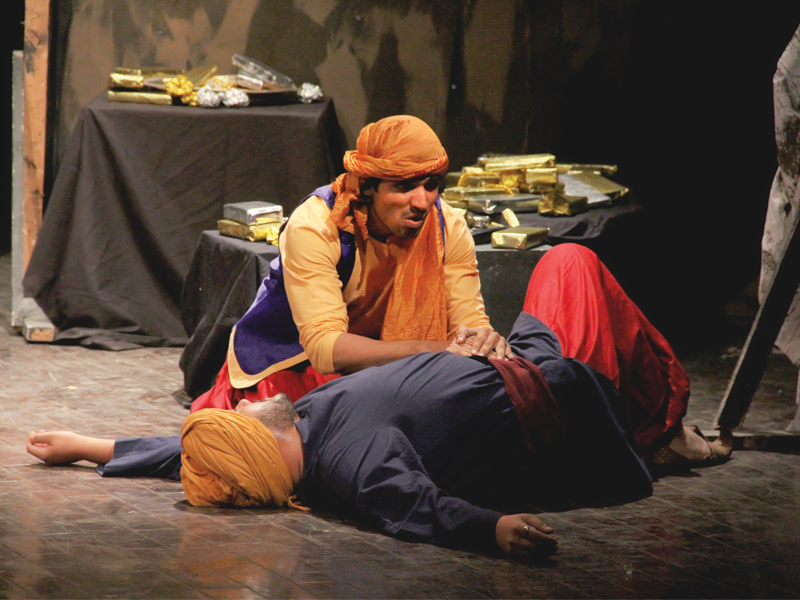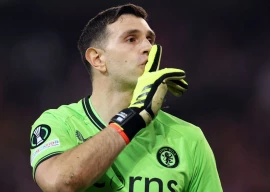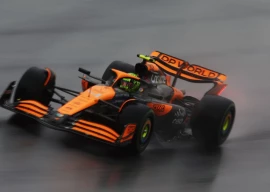
KARACHI:
When you think of na maloom afraad in the city, the image that comes to mind is that of men on motorcycles swerving through the streets, faces hidden with cloth, their guns glistening through their shirts.
No matter what their political affiliation or religious beliefs, these men are as much a part of Karachi as any other. Hence, when we are looking for these na maloom afraad, perhaps it is best to look within ourselves first.

A painting by Mohan Das is among those displayed at the Manzar Akbar Hall at Arts Council. PHOTOS: AYESHA MIR/EXPRESS, ATHAR KHAN/EXPRESS
To discuss the impact of these ‘unidentified’ men on law and order in Karachi, a panel discussion was held on the third day of the Pursukoon Karachi Festival. Sabeen Mahmud of The Second Floor café started the discussion with the obvious questions: why is Karachi so violent? Why are we on various lists of being a dangerous megacity? Who are these na maloom afraad?
For researcher Haris Gazdar, na maloom afraad is a mediatory term. “When you don’t want to say who caused the violence which is a dangerous concept as it is you use this term.” Yusra Askari objected. “Isn’t this merely one way to avoid blaming the right organisation or people?” Gazdar felt the euphemism exists because there are real dangers to you if you name them, and for this, the state is to blame.

Samundar Ki Chori - a dramatic reading of Asif Farrukhi's story by Zambeel Dramatics Readings. PHOTOS: AYESHA MIR/EXPRESS, ATHAR KHAN/EXPRESS
Zohra Yusuf of the Human Rights Commission of Pakistan pointed out that these men are no longer unidentified. “The Tehreek-e-Taliban Pakistan proudly claimed they planted the bombs to avenge the Rawalpindi incident,” she said, referring to the Ancholi blasts on Friday.
She accepted, however, that the violent actors have changed. The city may have witnessed it worse spells of ethnic violence when the Muttahida Qaumi Movement asserted itself as a political entity, but there are far too many actors causing violence today, she said.
What makes Karachi violent?
NGO Shehri-CBE’s Roland deSouza disagreed that violence in Karachi was merely ethnic. “We are only looking at proximate causes of violence,” he said. “If ethnicity is the only factor causing violence, what about the MQM versus the MQM-H?”

Students of the arts council drew a gun with chalk as part of the project, Guns Karo Bund. PHOTOS: AYESHA MIR/EXPRESS, ATHAR KHAN/EXPRESS
For him, the ultimate causes of violence were something else, and were far too dangerous. “There are just too many people in this world,” he smiled, shaking his head. He was hinting at the massive issues of urban governance in Karachi.
“Are you linking violence to the middle-class aspiration to get more,” Mahmud asked.
“It is not a middle class aspiration,” deSouza clarified. “It is human condition to desire more and more and what it leads to is a fight between the rich and the poor — the ones who want versus the ones who have.” It is, therefore, unfortunate that the ones who have also run the state, he added.

Rung De Karachi's graffiti has been put up at walls around Arts Council, NAPA and other parts of the city. PHOTOS: AYESHA MIR/EXPRESS, ATHAR KHAN/EXPRESS
AbbTak television’s bureau chief Alauddin Khanzada added a journalistic perspective to the panel. He blamed low tolerance levels for the growing violence. “Initially, it was a man with a knife who was most feared and he would only have to whip out his weapon for everyone to acquiesce to his demands,” he said, adding that there was hardly a desire to kill someone merely because they didn’t share your ethnicity or beliefs.
This led Norbert Almeida, who is popular on Twitter for his timely updates on Karachi violence, to lay down the facts on weaponisation in Karachi. “It has come down to the situation that people feel they should kill before getting killed,” he said, sharing how ordinary citizens are buying guns for their own protection. “You can no longer point fingers at one party and say they have weapons because each and every one of us has picked up weapons.” In fact, he pointed out, renting weapons is as easy as renting a motorcycle for a day.
Karachi versus Lahore
Yusuf wanted to know why Karachi is not as integrated into Sindh as Lahore is in Punjab or Peshawar in Khyber-Pakhtunkhwa. Gazdar said this is not entirely a bad thing as this isolation gives Karachi a unique autonomy. “People here can break away social binds and class differences and live with relative autonomy,” he explained, but accepted that this means governance becomes a problem.

Hum Sub, a culmination of the donkey cart racers, was held at the Arts Council . PHOTOS: AYESHA MIR/EXPRESS, ATHAR KHAN/EXPRESS
He gave the example of Lahore where the government can evict a katchi abadi and set up a park - something that cannot be done in Karachi. “Here, you can look at a katchi abadi and say ‘it used to be a park once’,” deSouza interrupted, as the audience laughed.
Is there hope?
For Khanzada, the solution lies with the police. “If the police are de-politicised, they can make Karachi pursukoon within 30 days.” His views may have been ambitious but Almeida agreed there was a need to empower the police. “Make them report all crimes, so they know what kinds of criminal activities are taking place in their area,” he suggested, adding this will make the police demand the right resources from the government.

A graffiti which reads, Karachi Humara hai Tumhara Nahi [Karachi is ours, not yours], is part of the Masla Kya Hai - I Protest Project at the NAPA compound wall. PHOTOS: AYESHA MIR/EXPRESS, ATHAR KHAN/EXPRESS
Gazdar also vouched for reversing the state’s breakdown that led to the formation of violent groups to begin with. DeSouza felt living the life the way of our grandparents will make us desire less, and hopefully, leave enough around for the rest of us.
Yusuf, on the other hand, shared little hope. “I have no solutions to offer,” she admitted.

But Mahmud wanted to end on a hopeful note. “Zakhm bhar jaye ga, gham na kar [The wound will heal, don’t worry],” she said, quoting Faiz Ahmed Faiz.
Published in The Express Tribune, November 25th, 2013.
COMMENTS (4)
Comments are moderated and generally will be posted if they are on-topic and not abusive.
For more information, please see our Comments FAQ





































1713525343-0/WhatsApp-Image-2024-04-19-at-4-09-16-PM-(1)1713525343-0-270x192.webp)
1713525453-0/Henry-Cavill-in-James-Bond-(AI)1713525453-0-270x192.webp)
























how many participants did attend these events in "Pursukoon". I think a very few peopel were turned up at every program, but such a excellent coverage. Good...... pls pay aslo attention to other geniune issues.
cheers
I like to add here one more and major problem that is the seats which are won from the limitation of Karachi have too much qualitative worth rather winning from any rural areas. Karachi seats are not easy to win...every nationality ,and every party stands to win from Karachi but when they win they dont have any superiority difference between those who win from rural areas where there is no media, no rival , no competition.
The very thing necessary is to give Karachi seats a priority that who ever wins the most seats in Karachi would be eligible to for the certain mandatory ministries in which Chief minister, Municipality Minister or Interior Minister. MQM having more than 80% stakes dont have the power for its any of the powerful seat. they are just given the option of Human rights , youth or worth less ministries... MQM have the potential to make the city better.. they know the problem, they know how to correct it...
The problem lies with ethnic parties MQM, PPP (Aman Committee) and ANP. The Haqiqi counter example is not currently all that relevant.
Where ethnic or religious fault lines exist, the government needs to arrange frank discussion between the two communities and come up with a mutually agreed formula for peaceful coexistence.